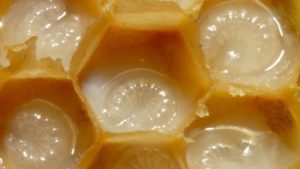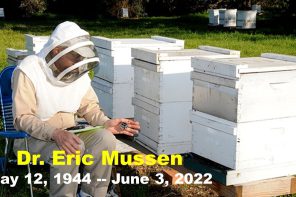Honey Bees, an Origin Story
By: Jay Evans
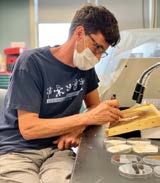
A long time ago, in a treehole far, far, away, our honey bee heroines started a journey that would plant them throughout the globe. For generations, scientists have puzzled over the timing of all this and the location of that treehole, or treeholes. Kathleen Dogantzis, Amro Zayed, and colleagues have applied their expertise and the latest genomic technologies to address this puzzle in the most complete way yet. Their paper, “Thrice out of Asia and the adaptive radiation of the western honey bee” was just published in the journal Science Advances (Vol 7, Issue 49, and freely available at DOI: 10.1126/sciadv.abj2151). In this study they sampled the entire genomes of 251 honey bees collected from the historical range of Apis mellifera (the ‘western’ honey bee, the species that is dominant among managed honey bees). Amidst these sampled genomes are bees from Europe, Africa, the Middle East and Asia, all places vying to be the source of A. mellifera.
So how does a genome sequence solve genealogies of this sort? First, there are millions of single variants (mutations that have survived time and selection) in the 230 million nucleotides that define the honey bee genome. There are four possible nucleotides at each of these 230 million slots, giving ample space to build up differences. Many of these variants differ within individual bees, while many more differ within populations and subspecies. Still others are distinct for individual subspecies. The latter class of variation is especially useful for studies like this one, where the goal is to find signals that unite subspecies and tie them to a common past.
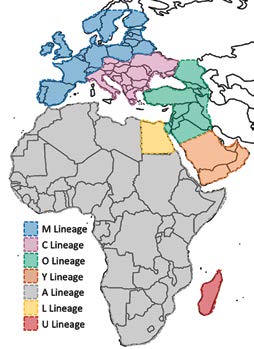
Amellifera Map
And how does one find and use these sequences? Genome sequences for bees, and all of life, really, are housed at the U.S. National Institutes of Health ‘Genbank’ resource (https://www.ncbi.nlm.nih.gov/). If you want all of the genome sequences used for this study you will soon find them at this site, alongside hundreds of other honey bee genomes including the ‘original’ honey bee genome sequence published in 2006. To tease apart differences between genomes, scientists align new sequences to a reference genome, head to tail along each of the 16 honey bee chromosomes. Mapping the genomic history of A. mellifera is helped by the fact that the genome of the Asian honey bee A. cerana, a close relative, is also known. Thanks to A. cerana, it is possible to ‘root’ each A. mellifera sequence to a long-gone bee that unites these two current species.
With buckets of data and this ‘root’ it should be easy to track the history of A. mellifera in the seven or so million years since this shared ancestor. Sadly, three facts obscure the honey bee family tree. First, evolution can happen in fits and starts and for much of the histories of the currently recognized subspecies not much happened. If new and informative lineages evolved, they either died out or have evaded scientists and their genome sequencing machines. In contrast, a lot happened in the world of A. mellifera in the past million or so years. If you picture the tips of the A. mellifera tree, they look like a palm tree with lots of branches right near the top, instead of an apple tree where important branches peel off lower on the trunk. Or, as argued by these authors, a three-tipped palm tree. This is really cool, because it shows that something really ‘clicked’ with A. mellifera more recently, allowing adaptation to diverse environments and climates and new dominance in the pollinator world (even prior to the human assist). We humans have caused a second bit of confusion in tracing the history of A. mellifera. For centuries, we have mixed and crossed otherwise solid subspecies, scrambling some of their unique histories. For one, European subspecies of A. mellifera have been returned to Asia under human management and have already shared genes with some of the Asian A. mellifera bees sampled in this project. Even the revered Middle-Eastern honey bee, Apis mellifera syriaca, shows a blend of distinct genetic codes reflecting admixture of other bees from close and far. Finally, there are large parts of the world where scientists have not scrutinized local honey bee stock, including areas where bees do not generally move around. To overcome these challenges, Dogantzis and colleagues combined an ambitious amount of collecting with the latest genomic toolkit to make sense of it all for us.
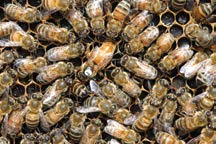
Photo by: Amro Z
The title of their paper gives away the punchline. It appears from this new effort that A. mellifera, like every other honey bee, got its start somewhere in Asia. Based on current populations this is likely western Asia, from which the ‘western’ honey bee moved west in waves to populate Africa, the Middle East, and Europe, long before we humans helped it move the rest of the way around the globe. Scientists had proposed this Asian origin before but it was challenged by data suggesting that the founding mothers of A. mellifera first leapt to Africa and then radiated out to the North and East from there. In the current paper, a first exodus from Asia led to the recognized African lineages of A. mellifera, while a second eventually gave rise to ‘carniolan’ and ‘Italian’ western subspecies, in sisterhood with ‘caucasian’ and ‘anatolian’ lines. A third lineage appears to have remained in Asia for millions more years before its own exodus, leading to the European ‘Spanish’ and ‘dark’ subspecies, A. m. iberiensis and A. m. mellifera. Each of these three branches can be tied to an Asian ‘root’, bolstering claims for an Asian origin of A. mellifera. The authors admit that ambiguities remain (science is great) and it will take heavier sampling, especially from Asia and ideally from ‘new’ lineages that are closer to the root of the tree, to build confidence in these results.
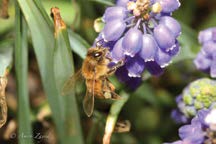
Photo by: Amro Z
Along with solving an origin story that has kept at least a handful of you up at night, this study gives practical insights into bee subspecies and races. The authors confirm the overall integrity of 10+ western and African subspecies, while bolstering several that were less solid, including a subspecies from the large island of Madagascar and key subspecies that remain viable in Asia. They also show 100+ specific genes that consistently pop up as evolving fastest on diverging honey bee branches. These genes are great candidates for understanding how managed bee lines react to climate, food, and perhaps even chemicals. It is apparent that many key genes are most active in worker bees as opposed to queens. This likely reflects the great range of environmental exposure found by workers across their lifetimes, from temperature extremes to close exposure to pollen and nectar chemicals. It might also reflect the larger behavioral repertoires of worker bees; dancing, defending, mapping, provisioning, etc., when compared to their own mothers. For queen breeders, these genes should be watched as markers for local adaptation, colony life histories and behaviors, and perhaps even responses to localized pests, pathogens, and chemicals. Honey bees continue on an epic and important journey. The fate of A. mellifera is in large part tied to humans currently, but a better understanding of its past struggles and successes should give new hope for ways to battle current forces and challenges.
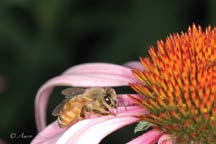
Photo by: Amro Z






